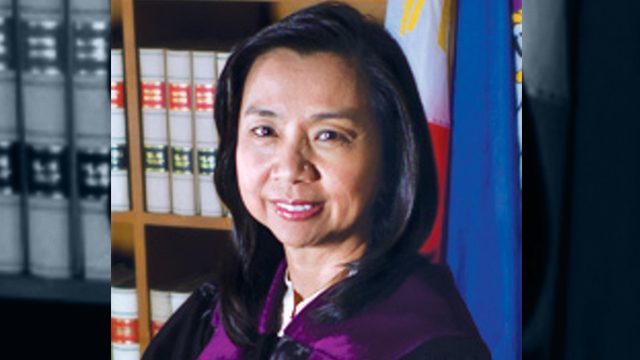SUMMARY
This is AI generated summarization, which may have errors. For context, always refer to the full article.

MANILA, Philippines – Supreme Court Associate Justice Estela Perlas-Bernabe has confirmed her nomination to the position of chief justice, Justice Secretary Menardo Guevarra, a member of the Judicial and Bar Council (JBC), said on Monday, October 15.
Guevarra said that Associate Justice Andres Reyes Jr also confirmed his nomination, making this his second try.
There are now 5 incumbent justices vying to be chief justice, a post vacated with the retirement of Teresita De Castro. The JBC extended the nomination deadline to October 26.
The 5 most senior justices are automatically nominated to the JBC.
Before Bernabe, who is the 5th most senior justice, Senior Associate Justice Antonio Carpio and Associate Justices Diosdado Peralta and Lucas Bersamin also confirmed their nominations.
The 4th most senior justice, Mariano Del Castillo, declined.
Who is Bernabe?
Bernabe is an appointee of former president Benigno Aquino III. She rose from the ranks as a metropolitan trial court judge to regional trial court judge and then Court of Appeals justice.
She joined the Supreme Court in September 2011, and will retire in May 2022.
A study on the Philippine Supreme Court recently released by Professor Bjorn Dressel of the Australian National University said that the justices’ social network affects how they vote on decisions.
“Two situations in particular may influence how each justice votes: (a) a justice appointed by the president in power may seek to influence other justices in the same networks to vote in the president’s favour – illustrating informal political pressure, as in the attitudinal model,” the study’s findings show, after analyzing 47 major cases between 1986 to 2015.
But this is not entirely true for Bernabe.
In the Court’s last major cases, she voted differently from fellow Aquino appointees.
In the Marcos burial case, Aquino appointees Maria Lourdes Sereno, Marvic Leonen, Francis Jardeleza and Benjamin Caguioa dissented, while Bernabe joined the majority that upheld the burial. (READ: How did SC justices vote on major political cases?)
In martial law in Mindanao, Bernabe and Jardeleza joined the majority in upholding its constitutionality, while the other Aquino appointees – Sereno, Leonen and Caguioa dissented. (Sereno and Caguioa wanted to limit the scope, Leonen voted against the entirety of martial law.)
In acquitting Gloria Arroyo of plunder, Bernabe and fellow Aquino appointee retired justice Bienvenido Reyes concurred, while the rest of the Aquino appointees dissented. (Note these were mostly 2016 to 2017 decisions, outside of the study’s scope.)
Bernabe, however, joined the dissenters in the quo warranto ouster of Sereno as chief justice. – Rappler.com
Add a comment
How does this make you feel?
There are no comments yet. Add your comment to start the conversation.